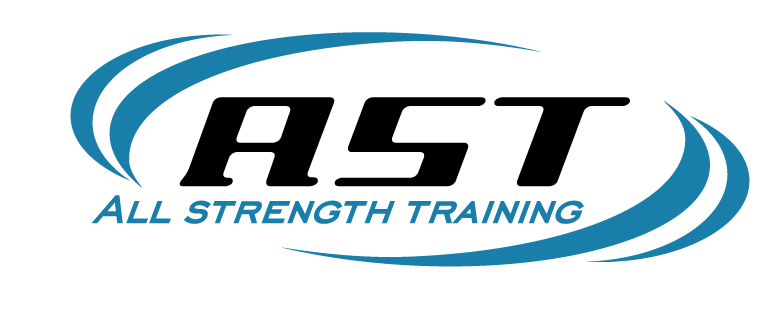Strength Training for Endurance Athletes

Although the idea of strength training to support recreational sports and activities is not new, there are still those who buy into several long-standing myths about training with weights. At the top of the list are endurance athletes. We work with many marathon runners and triathletes at AST, and have seen our athletes make tremendous improvements in performance with the right program.
Designing a Program
The first step is choosing the right program. The biggest mistake we see made is taking a program designed for another sport or activity and trying to apply it to endurance work. For example, taking random routines from fitness magazines that are designed for the masses and trying to apply it to a niche activity is a recipe for disaster. A good endurance program should be designed to cover the following aspects:
- developing muscular endurance in the primary muscles used
- strengthening weak and neglected muscles to maintain structural balance
- increasing mobility in tight muscles brought on by overuse
- developing strength endurance through the core and trunk musculature
- decreasing non-essential bodyweight to improve performance
Training Guidelines
There are, for the most part, two different types of muscles in the body – fast-twitch and slow-twitch. In simple terms, fast-twitch muscles are very powerful but fatigue very quickly, and are slower to recover, while slow-twitch muscles have greater endurance capabilities and recover more quickly, but have less potential for power and strength. Knowing which muscles tend to skew toward which type makes it easier to make the right adjustments to your training plan.
Common Fast-Twitch Muscles
- Lats
- Triceps
- Hamstrings
- Glutes
- Upper calf (gastrocnemius)
- Surface abdominals (rectus femoris, obliques)
Common Slow-Twitch Muscles
- Chest
- Upper back
- Shoulders
- Biceps
- Quads
- Lower back
- Deep abdominals (transverse abdominis)
Now, this list is by no means perfect – fiber type can vary based on the individual. This is just what we have found to be true in the majority of individuals that we work with.
So, what does this information mean? It gives a better indication of how to train those muscles correctly. Look at the slow-twitch muscles – those tend to be the areas most heavily involved in most endurance sports – running, swimming, and biking. The fast-twitch muscles tend to be neglected by endurance athletes and are vulnerable to injury if left unaddressed.
In general, here are some straightforward guidelines for strength training for fiber type:
Fast-twitch – low reps (3-8), longer rest times and a higher number of sets per exercise
Slow-twitch – higher reps (12-30), short rest intervals and a low number of sets
Flexibility, Mobility and Recovery
Another important component is maintaining mobility. Any muscle that is heavily recruited during a given activity will tend to become short and tight, and the opposing muscles will tend to become weak and lengthened. For example, a cyclist will develop tight pecs and lats because of the time spent slouched over the bike handles, and the upper back muscles will become weak from being left in a stretched position for long periods of time. So you would stretch and peform self-myofascial release (or foam rolling) for the tight area before training the weak area.
Here’s a good rule – if you can see it in a mirror, it’s probably tight. If you can’t, it’s probably weak. Prioritize your training and mobility programs around that axiom and it’s hard to go wrong.
Training the Core
There are two types of abdominal and core muscles – surface muscles, such as the rectus femoris (abdominal wall) and the obliques, lower back and glutes; and deep muscles, speficically the transverse (deep) abdominis. It’s appropriate to train both, but not the same way.
Surface muscles can be trained more conventionally – moderately heavy weights through a full range of motion, with the reps and loads varying depending on fiber type (see above). The transverse abdominis, however, is more of a stabilization muscle and does the job of bracing the trunk while you’re performing other activities, such as running or swimming. As such, you want to use movements that require you to hold the abs tight isometrically while performing other work.
Good Surface Muscle Exercises
- Leg raises (lying or hanging from a pullup bar)
- Crunch variations through a full range of motion (no swinging or flailing)
- Weighted side bends
- Back extensions and reverse hyperextensions
- Glute bridges
All of the above lifts can be trained with a reasonable amount of resistance for lower reps, without sacrificing technique.
Good Deep Core Exercises
- Front planks
- Side planks
- Inverted planks
- Plank to pushup
- Palloff press
- Plank knee-in
- Twisting plank
- Ab wheel
All of the above exercises should be performed for high reps or held for as long as possible. Planks are useful up to about 60 seconds, and side planks about 30 seconds. Once you can hold that long you should choose more challenging progressions such as the other exercises listed.
Controlling Body Composition
Last, but certainly not least, a good strength training program should prioritize increasing muscle mass and decreasing bodyfat. After all, would you be faster with 75lbs of bodyfat, or 15lbs of bodyfat? A male athlete should strive to stay under 10%, and a female under 18%. Anything else serves no purpose but to slow you down. And what good will that do?
